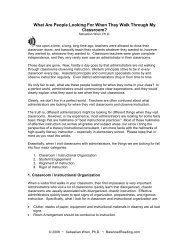The Abecedarian Reading Assessment - Balanced Reading
The Abecedarian Reading Assessment - Balanced Reading
The Abecedarian Reading Assessment - Balanced Reading
You also want an ePaper? Increase the reach of your titles
YUMPU automatically turns print PDFs into web optimized ePapers that Google loves.
We have attempted to create a flowchart to represent the way these knowledge domains<br />
relate to each other, and to give some information about how teachers can be strategic in<br />
thier assessment of early literacy skills. Unfortunately , while this flowchart is deceptively<br />
simple, children are diabolically complicated. However, this is still a good place to start.<br />
Keep in mind that the flowchart does not indicate the order that assessments should be<br />
given -- it indicates the order that most children develop these skills and knowledge<br />
domains.<br />
<strong>The</strong>re are six knowledge domains that can be assessed with the <strong>Abecedarian</strong>, and the<br />
flowchart organizes these domains, top to bottom, from “most advanced” to “most<br />
elementary.” Further, under most of the six knowledge domains the more basic tasks that<br />
can be used when giving the <strong>Abecedarian</strong> are listed. <strong>The</strong>se tasks, like the flowchart itself,<br />
are also ordered from “most advanced” to “most elementary.”<br />
Using this flowchart, teachers should be strategic about giving assessment. To a certain<br />
extent, it is necessary for the teacher to use his or her discression when determining where<br />
to begin testing different children. However, we have some tips that may be useful.<br />
All children should get the vocabulary assessment, and it is probably a good idea to give all<br />
three tasks of the vocabulary assessment. Vocabulary development is a life-long process,<br />
and all teachers should frequently assess the vocabulary development of their students.<br />
<strong>The</strong> most advanced children should begin with the decoding tasks -- if a child performs well<br />
on the decoding fluency task, there is probably no need for further assessment with the<br />
<strong>Abecedarian</strong> (other than vocabulary). A child who can decode words fluently has moved<br />
beyond the basic skills assessed by the <strong>Abecedarian</strong> and is ready for more advanced<br />
reading instruction. If the child does not perform well on the fluency section, then the more<br />
elementary <strong>Abecedarian</strong> subtests should be administered.<br />
Most children in Kindergarten and early first grade should begin with the letter knowledge<br />
and phoneme awareness tasks (and vocabulary, of course). With the phoneme awareness<br />
assessment, begin with segmentation. If a child passes the segmentation assessment,<br />
then no more assessment in phoneme awareness or phonological awareness is necessary<br />
-- move on to the alphabetic principle task. <strong>The</strong> more basic phoneme awareness and<br />
phonological awareness assessments are provided to get more information about children<br />
who cannot do the phoneme segmentation task.<br />
Understanding how these knowledge domains relate to each other and build on each other<br />
will help a teacher to be as efficient as possible in his or her assessment. Ideally, most<br />
children will only need to take a few subtests from the <strong>Abecedarian</strong> to give a teacher a<br />
good understanding of what instruction would best benefit that child.<br />
<strong>Abecedarian</strong> <strong>Reading</strong> <strong>Assessment</strong> • www.balancedreading.com • Page 3



